- Home
- Garden Wildlife
- Insects
- Hemiptera
- Shieldbugs
Denticulate leatherbug Coriomeris denticulatus. Photo on the right shows the nymph
Biology
Most shieldbugs feed by sucking sap from a wide range of plants but, with the exception of the southern green shieldbug, do not cause any noticeable damage. Some shieldbugs, such as the spiked shieldbug Picromerus bidens and the bronze shieldbug Troilus luridus, prey on other insects or suck the juices from dead caterpillars and other insects.
Life cycle
Shieldbugs often lay their eggs in compact groups on foliage. These hatch into nymphs that are more rounded in appearance than the adult insects. As they develop, the nymphs will pass through several instars and gradually take on the colour and shape of the adult. The overwintering stage for most shieldbugs is the adult insect, which hides in sheltered places.
Role of shieldbugs in gardens
Almost all shieldbugs in Britain and Ireland are a welcome addition to the wildlife of a garden, neither causing any problems nor being useful at control invertebrates that do cause problems. There are some concerns that the southern green shieldbug may become a problem, as its sap sucking activities can affect vegetable and fruit production, however it currently only becomes numerous late in the season when it is too late to cause significant damage.
Other sources of information
Website
Website of British Bugs
Heteroptera Facebook group
Books
Evans, M. & Edmondson, R. (2005) A photographic guide to the shieldbugs and squashbugs of the British Isles. Wild Guide UK
Hawkins, R. D. (2003) Shieldbugs of Surrey. Surrey Wildlife Trust
Shieldbugs identification chart Field Studies Council
Page drafted by Andrew Halstead, reviewed by Andrew Salisbury, edited by Steve Head
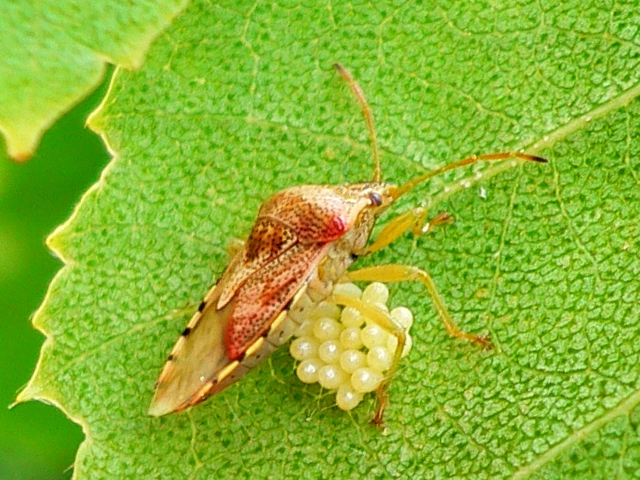
.jpg)
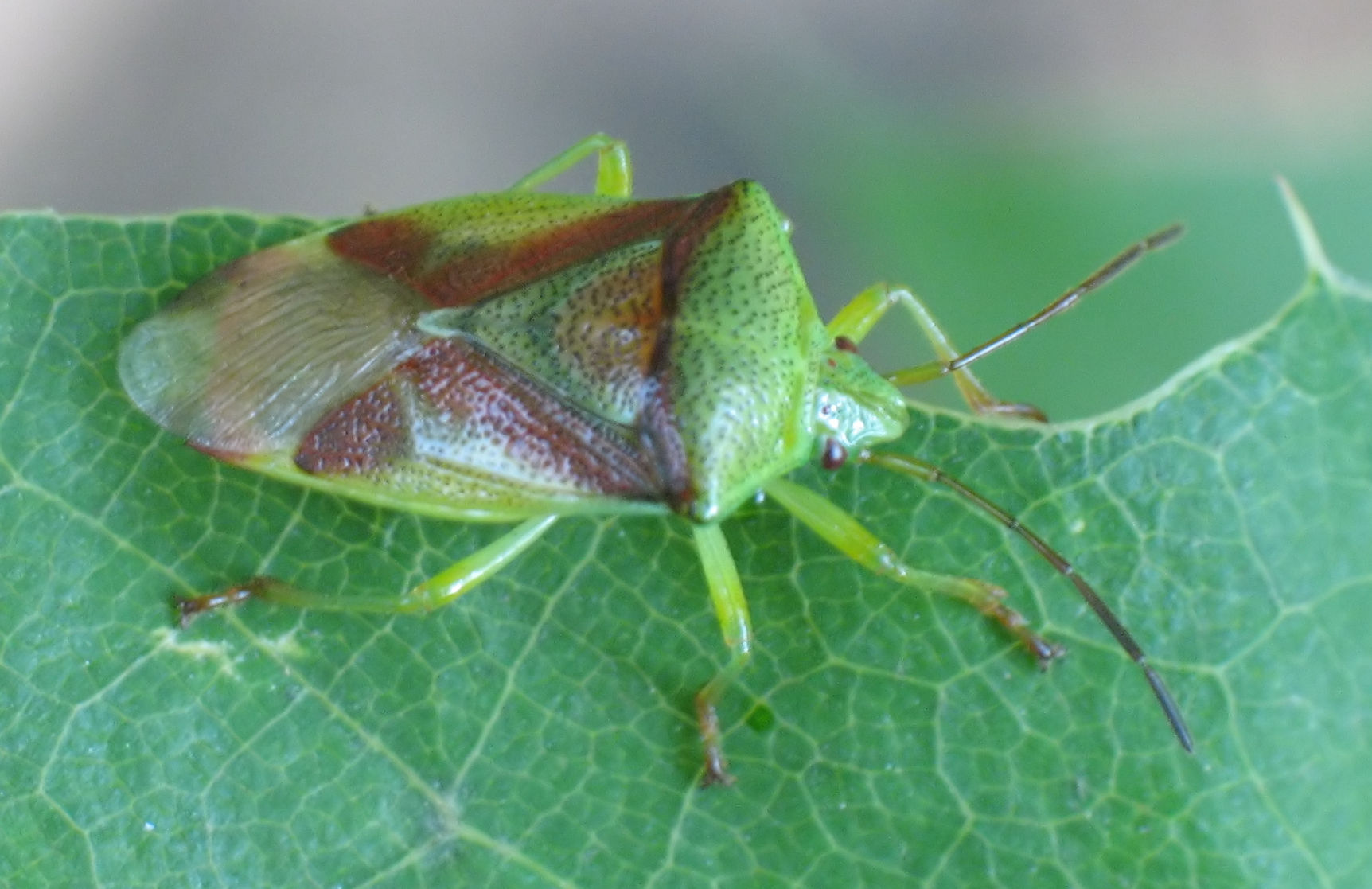
Shieldbugs
Shieldbugs are hemipterans, suborder Heteroptera superfamily Pentatomoidea The adult insects have relatively broad flat bodies that taper to the rear, which gives many species a distinctive shield-shape. They also have a characteristic scutellum, an extension of the rear of the thorax over the abdomen. They have moderately long antennae and their bodies are up to 16mm in length. There are 9 families of shieldbugs in Britain, three at least are relevant to gardens.
Species in Britain and Ireland
There are over sixty species of shieldbug in Britain and Ireland, including some non-native species that have become established. Species commonly found in gardens include:
Family Acanthosomatidae. There are four quite common British species in this family, and all were found by Jennifer Owen. The hawthorn shieldbug Acanthosoma haemorrhoidale was much the commonest, but she also found the birch shieldbug Elasmostethus interstinctus, the parent shieldbug Elasmucha grisea, and the juniper shieldbug Cyphostethus tristriatus
Hawthorn shieldbug Birch shieldbug Juniper shieldbug
Acanthosoma haemorrhoidale Elasmostethus interstinctus Cyphostethus tristriatus
Family Pentatomidae "stink bugs"
The stinkbugs, often called shieldbugs in Britain, are very like the Acanthosomatidae but have the ability to produce an unpleasantly pungent defensive spray when they feel threatened. The editor of this page has lost batches of elderflower wine when a stinkbug has accidentally come in with the elderflowers.
Jennifer Owen found three species in her study, the green shieldbug Palomena prasina, the woundwort shieldbug Eysarcoris venustissimus and the gorse shieldbug Piezodorus lituratus. The forest shieldbug Pentatoma rufipes is also quite common. The southern green shieldbug, Nezara viridula is a non-native species that has become established in gardens in the London area since 2003.
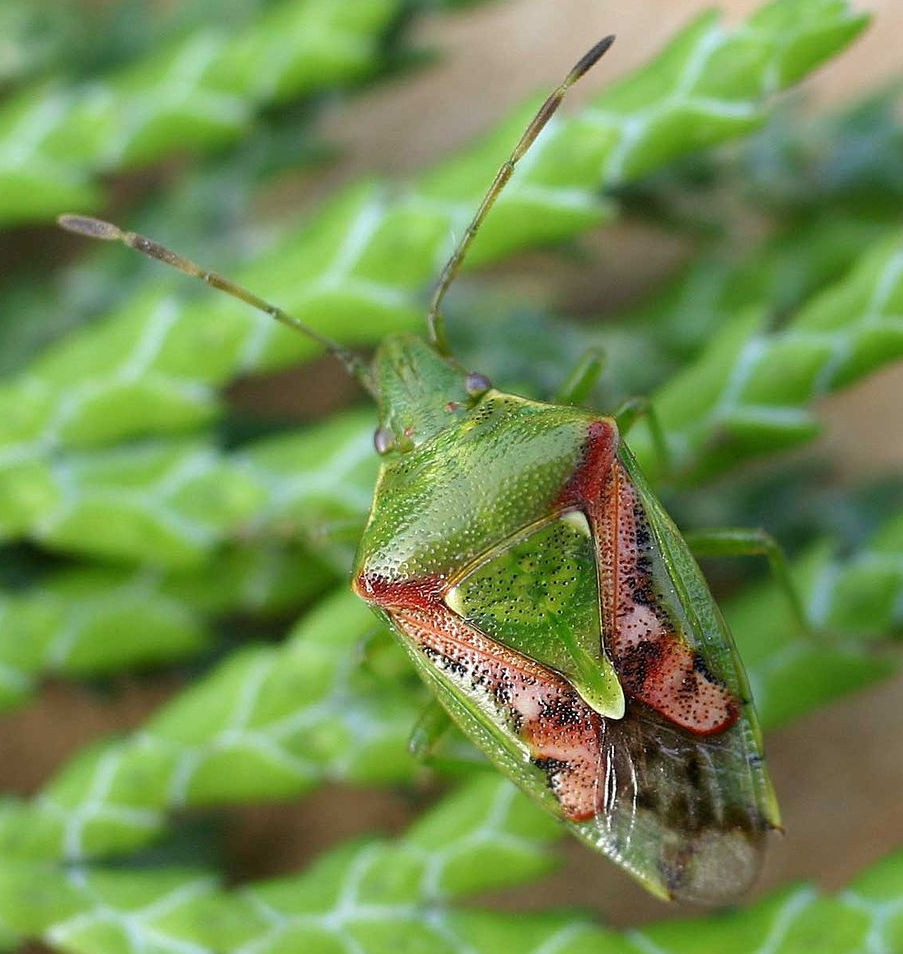
Green shieldbug Woundwort shieldbug Southern green shieldbug
Palomena prasina Eysarcoris venustissimus Nezera viridula
(Mating pair)
Family Coreidae "squash bugs" There are 11 species of coreid bugs in Britain, one of which, Coriomeris denticulatus the denticulate leatherbug, Jennifer Owen found in her garden study.
![Green shieldbug Palomen prasina Photo: James Lindsey at Ecology of Commanster [CC BY-SA 2.5 (https://creativecommons.org/licenses/by-sa/2.5)]](images/Palomena.prasina.jpg)
![Southern green shieldbug Nezera viridula Photo: Didier Descouens [CC BY-SA 3.0 (https://creativecommons.org/licenses/by-sa/3.0)]](images/Nezara_viridula_MHNT_verte.jpg)
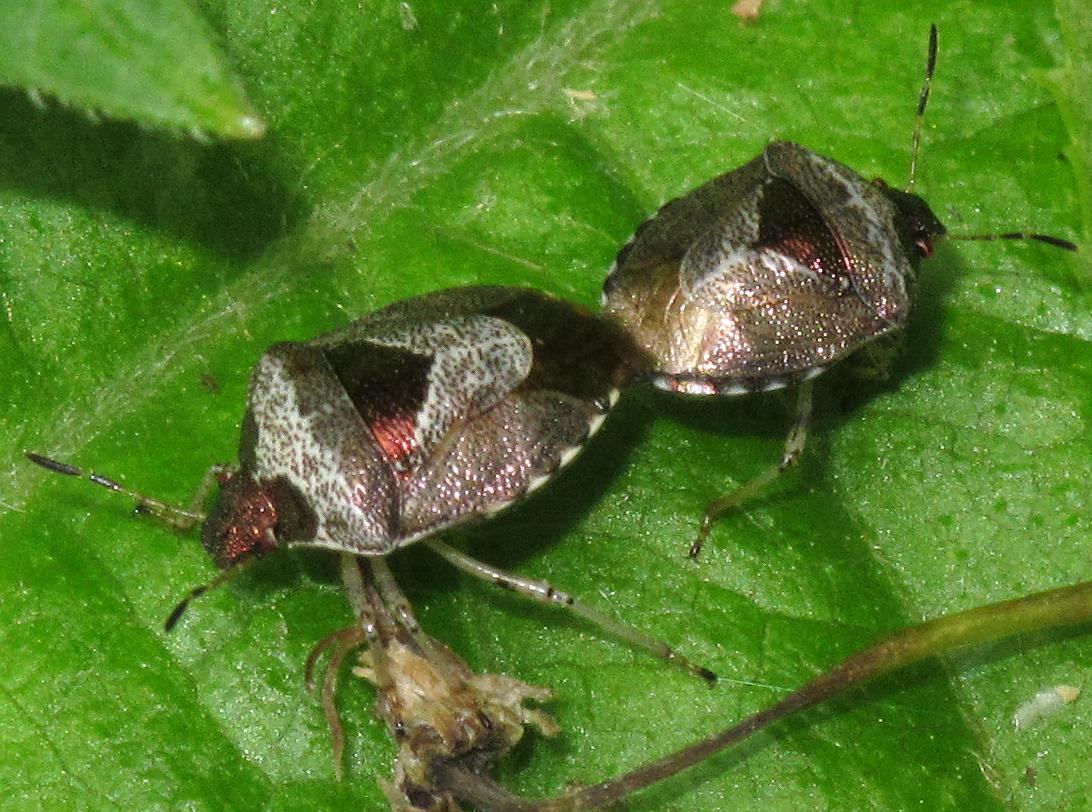
_(29974407077).jpg)
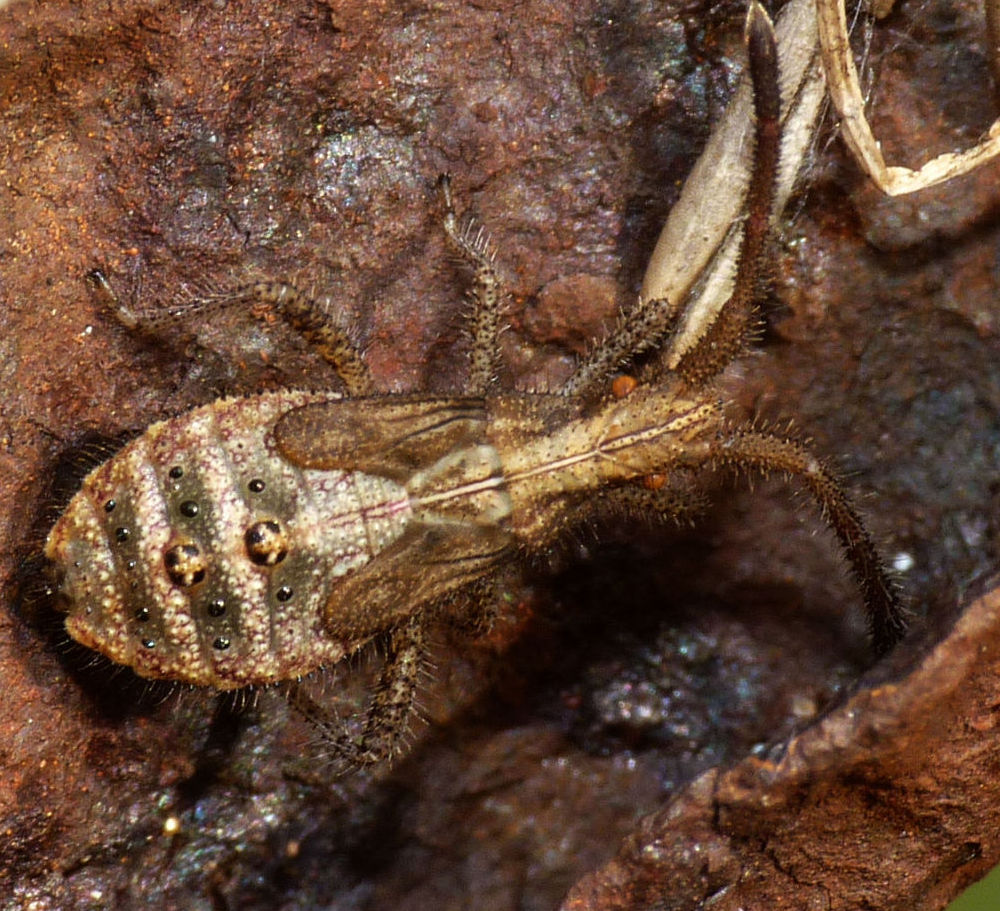
The parent shieldbug is one of the few insects that shows parental care for its offspring. Eggs are laid on the foliage of birch or alder and the female stays with her eggs to ward off predatory insects.
After hatching, the nymphs stay together as a family group, with the mother bug staying with them until they are about half grown.
The British Bugs website has some good images of the parent shieldbug with young.
Shieldbugs
Shieldbugs are hemipterans, suborder Heteroptera superfamily Pentatomoidea The adult insects have relatively broad flat bodies that taper to the rear, which gives many species a distinctive shield-shape. They also have a characteristic scutellum, an extension of the rear of the thorax over the abdomen. They have moderately long antennae and their bodies are up to 16mm in length. There are 9 families of shieldbugs in Britain, three at least are relevant to gardens.
Species in Britain and Ireland
There are over sixty species of shieldbug in Britain and Ireland, including some non-native species that have become established. Species commonly found in gardens include:
Family Acanthosomatidae. There are four quite common British species in this family, and all were found by Jennifer Owen. The hawthorn shieldbug Acanthosoma haemorrhoidale was much the commonest, but she also found the birch shieldbug Elasmostethus interstinctus, the parent shieldbug Elasmucha grisea, and the juniper shieldbug Cyphostethus tristriatus


.jpg)
The stinkbugs, often called shieldbugs in Britain, are very like the Acanthosomatidae but have the ability to produce an unpleasantly pungent defensive spray when they feel threatened. The editor of this page has lost batches of elderflower wine when a stinkbug has accidentally come in with the elderflowers.
Jennifer Owen found three species in her study, the green shieldbug Palomena prasina, the woundwort shieldbug Eysarcoris venustissimus and the gorse shieldbug Piezodorus lituratus. The forest shieldbug Pentatoma rufipes is also quite common. The southern green shieldbug, Nezara viridula is a non-native species that has become established in gardens in the London area since 2003.
Top left: Hawthorn shieldbug Acanthosoma haemorrhoidale
Top right: Birch shieldbug Elasmostethus interstinctus
Left: Juniper shieldbug Cyphostethus tristriatus
![Green shieldbug Palomen prasina Photo: James Lindsey at Ecology of Commanster [CC BY-SA 2.5 (https://creativecommons.org/licenses/by-sa/2.5)]](images/Palomena.prasina.jpg)
Family Coreidae "squash bugs" There are 11 species of coreid bugs in Britain, one of which, Coriomeris denticulatus the denticulate leatherbug, Jennifer Owen found in her garden study.

![Southern green shieldbug Nezera viridula Photo: Didier Descouens [CC BY-SA 3.0 (https://creativecommons.org/licenses/by-sa/3.0)]](images/Nezara_viridula_MHNT_verte.jpg)
Top left: Green shieldbug Palomena prasina
Top right: Woundwort shieldbug Eysarcoris venustissimus (Mating pair)
Left: Southern green shieldbug Nezera viridula

_(29974407077).jpg)
Denticulate leatherbug Coriomeris denticulatus. Photo on the right shows the nymph
Biology
Most shieldbugs feed by sucking sap from a wide range of plants but, with the exception of the southern green shieldbug, do not cause any noticeable damage. Some shieldbugs, such as the spiked shieldbug Picromerus bidens and the bronze shieldbug Troilus luridus, prey on other insects or suck the juices from dead caterpillars and other insects.
Life cycle
Shieldbugs often lay their eggs in compact groups on foliage. These hatch into nymphs that are more rounded in appearance than the adult insects. As they develop, the nymphs will pass through several instars and gradually take on the colour and shape of the adult. The overwintering stage for most shieldbugs is the adult insect, which hides in sheltered places.
The parent shieldbug is one of the few insects that shows parental care for its offspring. Eggs are laid on the foliage of birch or alder and the female stays with her eggs to ward off predatory insects.
After hatching, the nymphs stay together as a family group, with the mother bug staying with them until they are about half grown.
Role of shieldbugs in gardens
Almost all shieldbugs in Britain and Ireland are a welcome addition to the wildlife of a garden, neither causing any problems nor being useful at control invertebrates that do cause problems. There are some concerns that the southern green shieldbug may become a problem, as its sap sucking activities can affect vegetable and fruit production, however it currently only becomes numerous late in the season when it is too late to cause significant damage.
Other sources of information
Website
Website of British Bugs
Heteroptera Facebook group
Books
Evans, M. & Edmondson, R. (2005) A photographic guide to the shieldbugs and squashbugs of the British Isles. Wild Guide UK
Hawkins, R. D. (2003) Shieldbugs of Surrey. Surrey Wildlife Trust
Page drafted by Andrew Halstead, reviewed by Andrew Salisbury, edited by Steve Head

Parent shieldbug Elasmucha grisea with eggs












